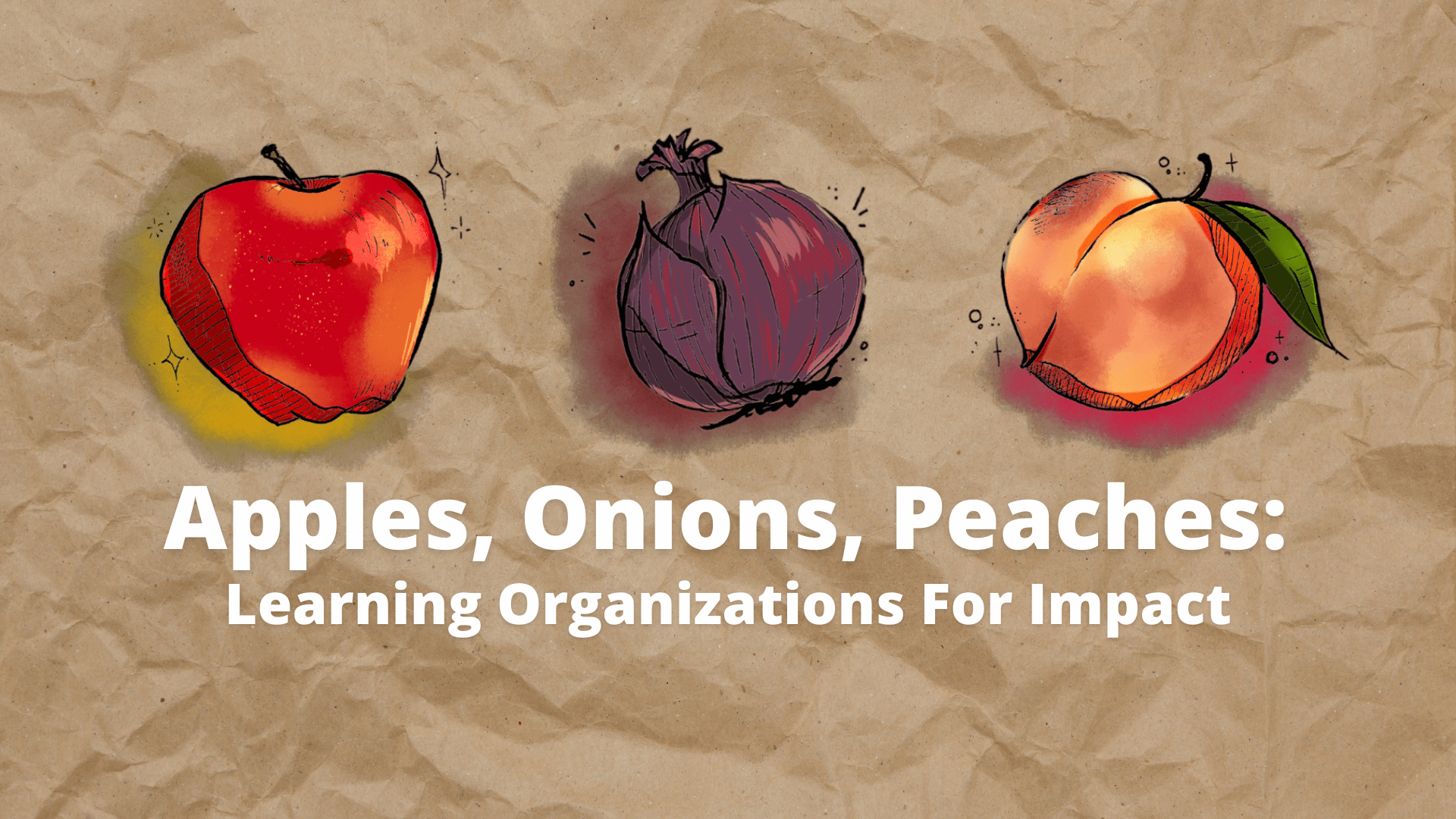
Annika Voltan
Executive Director
On Friday afternoons, the CSCNS team closes out the week with our A.O.P. meetings. They started several months ago when our colleague Emma shared that she uses “Apples, Onions, and Peaches” at the dinner table to encourage her young daughters to share what’s happening in their lives. This practice came up at a time when we were consciously looking for ways to integrate regular reflection, learning, and celebration into the culture we’re co-creating. Apples are the sweet wins that happened during the week, onions are those crunchy bitter things, and peaches are the juicy learning moments. Sprinkle in some kudos and it’s a nice way to finish even the most draining of weeks!
But in the context of this blog, onions aren’t reduced to the just the crunchy, bitter things. Instead, they’re a metaphor for what A.O.P. represents for our team – layers of practices and behaviours that contribute to an organization’s culture and, ultimately, its impact.
One of the key areas of our work is related to capacity building for the community impact sector in Nova Scotia. But with the diversity of organizations, the varying needs and skillsets, and exploding availability of content – it’s hard to know where to start. So, we made an intentional decision to try to go deeper, to peel back the layers to better understand the conditions for impact. Based on what we’ve learned, we’re advocating for a shift in organizations to prioritize trust-building, emotional wellbeing, and nurturing learning cultures.
Beginning with the Whole: Innovation & Impact
 From the outside, an onion can look seamless and simplistically whole. In the context of community impact, we sometimes marvel at the effectiveness of an organization’s work and draw attention to how socially innovative it is without recognizing the complex layers underneath. While it’s true that novel social innovations can help address the issues and inequities we’re facing, they often don’t emerge without the underlying relationship building and commitments to processes that encourage experimentation and adaptiveness – work that is time consuming, difficult, and often near impossible to convince funders it’s worthy of investment.
From the outside, an onion can look seamless and simplistically whole. In the context of community impact, we sometimes marvel at the effectiveness of an organization’s work and draw attention to how socially innovative it is without recognizing the complex layers underneath. While it’s true that novel social innovations can help address the issues and inequities we’re facing, they often don’t emerge without the underlying relationship building and commitments to processes that encourage experimentation and adaptiveness – work that is time consuming, difficult, and often near impossible to convince funders it’s worthy of investment.
The Next Layer: Evaluation & Reporting
The outer layer of the onion is often the most distinct from the rest and peels off with little effort. But there’s usually another outside layer that’s a little tough and pulls away easily. I’m going to use this one to reference evaluation and reporting. This is not to discount the importance of accountability and evaluation (in the same way that innovation and impact are critical) – but there’s a tendency for them to be done in a vacuum, to check a box off a funder’s list. Most community organizations can’t afford an in-house evaluator and the learning opportunity gets lost in the crunch to meet deadlines while doing the work – and, too often, someone else’s priorities for reporting that feel disconnected from what’s happening on the ground.
there’s usually another outside layer that’s a little tough and pulls away easily. I’m going to use this one to reference evaluation and reporting. This is not to discount the importance of accountability and evaluation (in the same way that innovation and impact are critical) – but there’s a tendency for them to be done in a vacuum, to check a box off a funder’s list. Most community organizations can’t afford an in-house evaluator and the learning opportunity gets lost in the crunch to meet deadlines while doing the work – and, too often, someone else’s priorities for reporting that feel disconnected from what’s happening on the ground.
The Juicy Parts: Learning Organizations
 This brings me to the inner layers – those juicy ones that trigger tears (maybe a good analogy for the emotional aspects of this work!) – the learning culture. Michael Quinn Patton, developmental evaluation guru, notes that an inadequate learning culture acts as a barrier to nurturing evaluation. A report by Taylor Newberry Consulting (2018) includes the quote:
This brings me to the inner layers – those juicy ones that trigger tears (maybe a good analogy for the emotional aspects of this work!) – the learning culture. Michael Quinn Patton, developmental evaluation guru, notes that an inadequate learning culture acts as a barrier to nurturing evaluation. A report by Taylor Newberry Consulting (2018) includes the quote:
“An organization may design an elegant and comprehensive evaluation system (…) but if it lacks a learning culture, the system will have little to no effect in making evaluation strategic and useful. Evaluation, at its core, is a means for learning, adapting, and changing. Organizations need to support a culture of risk taking, trust, tolerance for failure, and curiosity if they are truly going to benefit from evaluation efforts.”1
So what are the elements of a learning culture or learning organization? Aguilar (2016) groups them as the learning environment, learning processes and practices, and leadership. For example, the learning environment includes conditions such as psychological safety, appreciation of difference, feedback, etc. Processes and practices (like our A.O.P. meetings) encourage group learning and sharing. Leadership entails modeling, adherence to processes, and openness to different perspectives. When these practices aren’t effectively embedded and nurtured, we can go through the motions of getting work done without stopping to reflect on how we’re doing it, what we’re learning, and the adjustments we can make along the way to strengthen our impact. But the reality is that these conversations and processes take time, often surface tensions, and are typically easiest to move off the priority list.
The Inner Core: Culture of Trust & Wellbeing
At the heart of innovation and impact is an internal culture that promotes trust and team wellbeing. Through workshops, resources, and conversations the CSCNS recently called attention to the burnout pandemic in the sector. This is likely connected in part to a need to do better at cultivating workplaces where conflict is effectivelynavigated, and where people feel emotionally prepared, valued and connected to the organization’s purpose.
conversations the CSCNS recently called attention to the burnout pandemic in the sector. This is likely connected in part to a need to do better at cultivating workplaces where conflict is effectivelynavigated, and where people feel emotionally prepared, valued and connected to the organization’s purpose.
Learning and innovation require experimentation and an acceptance that not every effort will be a success – a mindset that is much more normalized in the private sector than in the community sector. But if we are to make progress on the complex issues we’re facing, we need courageous new ideas. This feels unlikely if we do not have cultures where people feel like it’s ok to speak up, to express dissenting views, or to hit pause on ideas and projects that aren’t creating the intended outcomes. We need to build capacity at all levels of organizations to be able to navigate diverse views, conflict, and preserve mental wellbeing.
Furthermore, if we are to address systemic racism and affect change with justice, equity, diversity and inclusion (JEDI) at the centre, the ability to navigate difficult conversations, create spaces with psychological safety and develop trust will be critical.
Going Forward from Here
This spring we partnered with Inspiring Communities to deliver a sector survey on capacity building needs. Our early analysis of the 193 responses confirmed that learning organizations are indeed a predictor of social impact, and that a culture of trust and wellbeing is a strong predictor of whether an organization has the characteristics of a learning culture. Soon we will be presenting more about what we heard and how it will inform our approach to developing capacity building opportunities.
To funders, we encourage a movement toward more trust-based philanthropy and co-created approaches to evaluation and reporting, where time for internal learning processes is built into funding agreements.
To sector leaders, we hope you find this resonates and that the ideas motivate you to commit to developing your internal practices and processes to increase your impact potential.
1 Preskill, H. & Mack, K. (2013). Building a Strategic Learning and Evaluation System for Your Organization, p.23.
- The Barefoot Guide 2: Learning Practices in Organisations and Social Change
- Achieving Greater Impact by Starting with Learning: How grantmakers can enable learning relationships at the grant application stage (Taylor Newberry Consulting, 2018)
- Indicators of a Learning Organization (Elena Aguilar, 2016)
- The Challenge of Organizational Learning (Stanford Social Innovation Review, 2011
Authored by:

Annika Voltan
Exeuctive Director

0 Comments